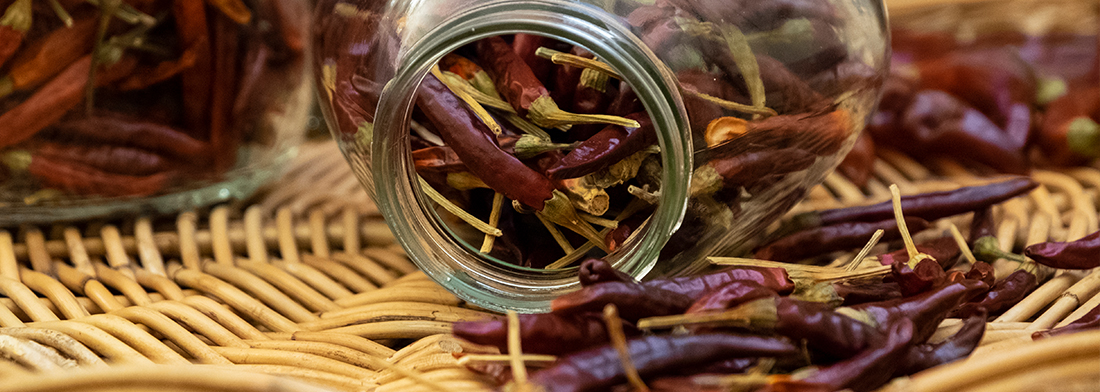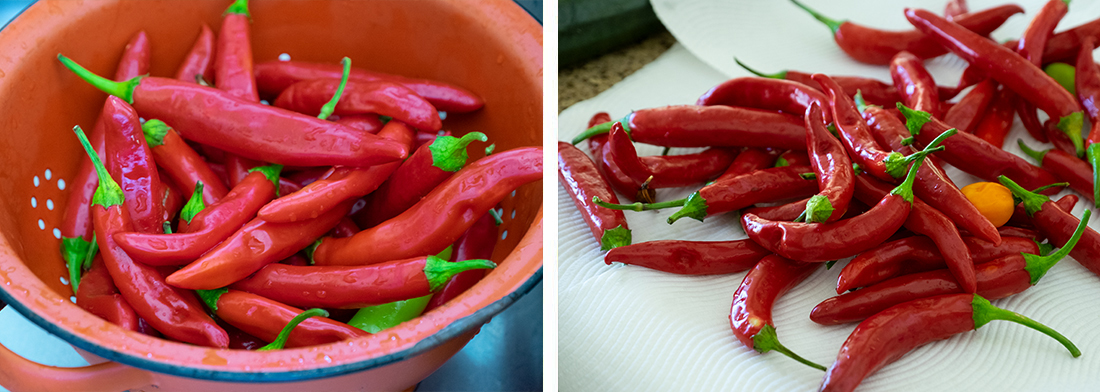Dried Chillies
- Drying, Salting & Potting

Capture the intense spicy pepper-like flavor of chilli using one of the oldest and simplest preserving methods – drying. Using a home dehydrator kit or the oven is a quick fool-proof drying method that doesn’t rely on weeks of intensive summer temperatures with relatively low humidity, that’s required for the traditional open-air method. Dried chilli develops an earthy, woody and nutty flavor complexity that is rare among other herbs and spices. Substitute dried chilli in recipes throughout the year, make your own special chilli powder blend with dried ground cumin, garlic and oregano or grind finely to make a hot chile powder.
Chilli heat, measured in Scoville Heat Units, comes from a natural compound capsaicin, found in the pith and seeds. Chilli heat in cooking can be controlled by removing as much or little of the white pith and seeds according to your taste and love of chili’s fiery pungency.
INGREDIENTS

METHOD
Select fresh crisp chillies. Wash to remove any garden debris if home grown or to remove any dust if purchased. Dry on paper towel or with a tea towel to remove excess moisture.
Place prepared chillies evenly, in a single layer onto drying trays. Make sure the hot air can circulate freely and chillies are not stacked on top of each other as this inhibits drying.
As each tray is filled, place it on the dehydrator and cover with the lid. Dry at 46 degrees C for approximately 8 hrs or until dry. Drying time is influenced by the size of the chilli and some may dry in a shorter time than others.
Remove dried chillies, allow to cool and place in an airtight container.
How to test if the chilli is dry? They should be pliable and leathery with no pockets of moisture. Not tough and crisp as this indicates they have been over dried which results in a loss of texture and taste.
NOTES
- Set dehydrator on a sturdy level countertop or table near a power point.
- Don’t overlay chillies in the tray as this will inhibit the drying process.
- If drying is uneven, remove dried chillies, cool and place into airtight storage container and continue to dry the other chillies.
- There are no absolutes in drying times as size, moisture content and freshness can all affect the drying process.
- Do not add fresh chillies to partially dried batch as this will slow the drying rate of both batches.
- Do not turn off the dehydrator and leave partially dried chillies sitting in the trays as the food will spoil and can develop “off flavours”.
- Chillies can be dried either whole or in halves with the skin side down. I prefer to dry them whole to maximize flavour and heat.
- Removing the seeds will reduce the hotness. The amount of seeds used can be varied or removed completely when they are being used in a recipe, depending on the desired amount of chilli heat required.
- Store in an airtight moisture proof container and label. Store in cool dry and dark place. The ideal storage temperature for dehydrated food is 15 degrees C to below freezing.
- Why is chilli hot
The legendary heat comes from a natural compound, capsaicin, which develops and is concentrated in the white pith with some migrating to the seeds. The amount of capsaicin a chilli contains depends upon the chilli variety and growing condition. High temperatures and drought can increase capsaicin production as the chilli ripens. To control and reduce the amount of heat, use the most appropriate variety and amount of chilli, remove as much or little of the white membrane and seeds and vary the length of contact time with other ingredients while cooking to suit your taste.
The Scoville Heat Units (SHU), developed in 1912! measures chilli heat or pungency. The higher the Scoville rating the hotter the chilli. The ubiquitous Jalapeno varies between 2,500 – 10,000 SHU which is mild compared to the Habanero and Scotch Bonnets 80,000 – 150,000 SHU or the hottest chilli in the world, the Carolina Reaper, which has been measured at 2million SHU! Aptly named the Reaper; use with extreme caution.
Chilli (native Nahuatl word), also referred to as chili or hot peppers (USA) or chile (Spanish) is native to South America. They were traded across the Andes and established in America and the subtropics until they were discovered by Christopher Columbus in the West Indies. Travelling the world trade routes together, the chilli was quickly embraced in Europe as it provided a similar spicy characteristic to foods as true pepper (Piper nigrum) at a fraction of the price. Today chilli is one of the most widely grown spices in the world.
